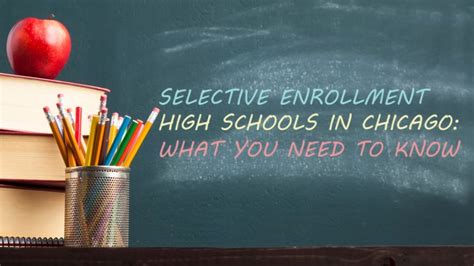Unlocking Educational Excellence

Selective enrollment schools are highly competitive institutions that admit students based on academic achievement and potential. They offer rigorous curricula, small class sizes, and a wealth of extracurricular activities, providing students with an exceptional educational experience. In this comprehensive guide, we will explore the benefits, challenges, and application process of selective enrollment schools, empowering parents and students to make informed decisions about this transformative educational pathway.
Benefits of Selective Enrollment Schools
1. Rigorous Curricula
Selective enrollment schools place a strong emphasis on academic rigor, preparing students for the rigors of college and beyond. They offer a challenging curriculum that includes advanced coursework, honors classes, and independent study opportunities.
2. Exceptional Teachers
Selective enrollment schools attract highly qualified and experienced teachers who are passionate about education. These teachers provide personalized instruction, support student learning, and encourage intellectual curiosity.
3. Small Class Sizes
Small class sizes are a hallmark of selective enrollment schools. This allows teachers to provide individualized attention to each student, fostering a supportive and collaborative learning environment.
4. Extracurricular Activities
Selective enrollment schools offer a wide range of extracurricular activities, including sports, clubs, music, and theater. These activities provide students with opportunities to develop leadership skills, pursue their interests, and interact with peers outside of the classroom.
Challenges of Selective Enrollment Schools
1. Competitive Admissions
Selective enrollment schools have highly competitive admissions processes, with acceptance rates often below 10%. Students must perform exceptionally well on standardized tests, have strong academic records, and demonstrate leadership abilities to be considered for admission.
2. High Expectations
Selective enrollment schools have high expectations for their students. Students are expected to excel academically, participate in extracurricular activities, and contribute to the school community. This pressure can be challenging for some students.
3. Limited Availability
Selective enrollment schools are typically limited in number and geographic distribution. This can make it difficult for students in certain areas to access these schools.
Application Process for Selective Enrollment Schools
1. Research and Identify Schools
Begin by researching selective enrollment schools in your area. Consider their academic reputation, curriculum, extracurricular offerings, and admissions criteria.
2. Prepare for Standardized Tests
Standardized tests, such as the ISEE and SSAT, are essential for selective enrollment school applications. Students should start preparing for these tests early and take practice tests to identify areas of improvement.
3. Build a Strong Academic Record
Maintain a high GPA in core academic subjects. Take challenging courses and excel in them to demonstrate your academic abilities.
4. Participate in Extracurricular Activities
Get involved in extracurricular activities that showcase your leadership, creativity, and teamwork skills. This can include sports, clubs, music, or volunteer work.
5. Write a Compelling Essay
The application essay is an opportunity to share your unique story and demonstrate why you would be a valuable addition to the selective enrollment school community.
6. Submit Your Application
Submit your application early to improve your chances of admission. Ensure that your application is complete and error-free.
Table 1: Key Statistics on Selective Enrollment Schools
| Statistic | Number |
|---|---|
| Number of selective enrollment schools nationwide | 1,000+ |
| Average acceptance rate | 10% |
| Percentage of students who attend college | 95% |
| Percentage of students who graduate from college | 80% |
Table 2: Pros and Cons of Selective Enrollment Schools
Pros:
- Rigorous curricula
- Exceptional teachers
- Small class sizes
- Extracurricular activities
- High college acceptance and graduation rates
Cons:
- Competitive admissions
- High expectations
- Limited availability
- Pressure to excel
Table 3: Pain Points and Motivations of Students in Selective Enrollment Schools
Pain Points:
- High workload
- Stress and pressure
- Lack of free time
- Competition
Motivations:
- Desire for academic excellence
- Preparation for college
- Personal growth and development
- Access to opportunities
Table 4: Step-by-Step Approach to Applying to Selective Enrollment Schools
Step 1: Research and Identify Schools
- Visit school websites and attend information sessions.
- Talk to current students and alumni.
- Consider your academic goals and interests.
Step 2: Prepare for Standardized Tests
- Start preparing early and take practice tests.
- Focus on areas where you need improvement.
- Seek professional help if necessary.
Step 3: Build a Strong Academic Record
- Take challenging courses and perform well in them.
- Maintain a high GPA in core academic subjects.
- Seek academic support when needed.
Step 4: Participate in Extracurricular Activities
- Get involved in activities that showcase your abilities.
- Consider leadership positions and community service.
- Strive for excellence in your extracurricular pursuits.
Step 5: Write a Compelling Essay
- Share your unique story and experiences.
- Demonstrate your passion for learning and commitment to the school community.
- Get feedback from teachers, parents, or writing coaches.
Step 6: Submit Your Application
- Submit your application early and ensure that it is complete and error-free.
- Request letters of recommendation from teachers or mentors.
- Attend interviews if required.
Conclusion
Selective enrollment schools offer an exceptional educational experience that can provide students with a strong foundation for success in college and beyond. While the challenges of highly competitive admissions and high expectations are real, the benefits of rigorous curricula, exceptional teachers, and a supportive learning environment far outweigh them. By carefully considering the information presented in this guide and following a well-structured application process, students can increase their chances of admission to selective enrollment schools and embark on a transformative educational journey.
